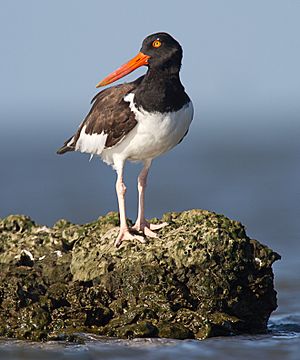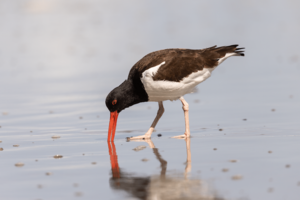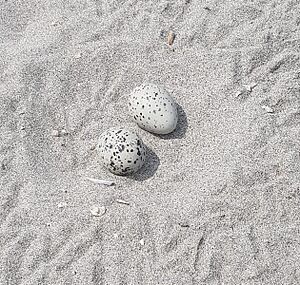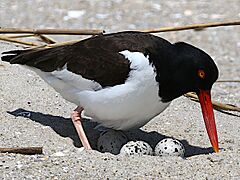American oystercatcher facts for kids
Quick facts for kids American oystercatcher |
|
|---|---|
 |
|
| American oystercatcher pair with chick at Fort Tilden, New York | |
| Conservation status | |
| Scientific classification | |
| Genus: |
Haematopus
|
| Species: |
palliatus
|
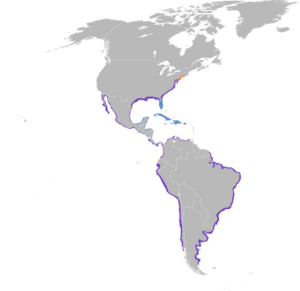 |
|
| Year-round
Breeding Nonbreeding |
|
The American oystercatcher (Haematopus palliatus) is a special bird found along the coasts. It's sometimes called the American pied oystercatcher. This bird got its name because a naturalist named Mark Catesby saw it eating oysters in 1731. Before that, people called it a "sea pie."
Today, there are about 43,000 American oystercatchers. Around 1,500 pairs of these birds raise their young along the Atlantic and Gulf Coasts of the United States. You can easily spot this bird by its black and white body and its long, thick, bright orange beak.
Contents
What Does an American Oystercatcher Look Like?
American oystercatchers have unique black and white feathers. They also have a long, bright orange beak. Their head and chest are black. Their back, wings, and tail are a greyish-black color.
The underside of their body is white. You can also see white feathers on the inside of their wings when they fly. Their eyes have yellow centers and orange rings around them. Their legs are pink. Adult birds are about 42 to 52 centimeters (16.5 to 20.5 inches) long.
Where Do American Oystercatchers Live?
You can find the American oystercatcher along the Atlantic coast of North America. They live from coastal Massachusetts down to northern Florida. They are also found along the Gulf Coast, in the Caribbean, and south to Brazil, Uruguay, and Argentina.
On the Pacific coast, they live in California, Mexico, Central America, Peru, and Chile. A long time ago, in the 1800s, these birds almost disappeared from the northeastern United States. This was because people hunted them and collected their eggs.
After they were protected by the Migratory Bird Treaty Act, their numbers grew. They moved back into their old homes along the coast in the Northeast. During the breeding season, they are found along the Atlantic and Gulf Coasts. In winter, they gather in large groups along the coast from central New Jersey to the Gulf of Mexico.
What Kind of Home Do They Like?
American oystercatchers live in coastal areas. During the breeding season, they like sandy beaches or shell beaches. They also live in dunes, salt marshes, and mudflats. Sometimes, they use islands made from sand or gravel that people have created.
When they are migrating or in winter, they look for food in mudflats or salt flats. These areas are uncovered when the tide goes out. They also like to find food on beaches where shellfish live.
How Do American Oystercatchers Behave?
Oystercatchers always stay close to the coast. They build their nests on coastal islands. They eat small sea animals without backbones, called marine invertebrates. Their big, strong beak helps them open up shellfish like clams and oysters.
How Do They Find Food?
American oystercatchers eat mostly shellfish and other sea creatures. Oysters are a big part of their diet, just like their name says. But they also eat mussels, clams, limpets, sea urchins, starfish, crabs, and worms.
They use their beaks to catch shellfish. As they walk across a bed of shellfish, they look for a mollusk with a shell that is slightly open. When they find one, they quickly jab their beak into the shell. This cuts the muscle that holds the shell shut.
Sometimes, this can be risky. If they don't cut the muscle completely, the shell might clamp down on their beak. A strong mollusk can hold the bird in place until the tide comes in, which can be dangerous. They also find food by carrying loose shellfish out of the water. Then, they hammer at the shell to open it. Or, they might dig in the sand for soft-shell or razor clams.
How Do They Find a Mate?
American oystercatchers usually start to breed when they are 3 or 4 years old. When a pair is courting, they walk together and make a special piping sound. Then, they might lean towards each other, lower their necks, and run side-by-side while calling out. The pair might then fly together in a close formation around their territory.
How Do They Reproduce?
Nests
American oystercatchers lay their eggs between April and July. Their nests are shallow dips in the sand. An adult bird scrapes these dips. Breeding adults will make 5 or more of these scrapes. Then, they choose one to line with shells or small pebbles. These nests are about 8 inches (20 centimeters) wide and 2.5 inches (6.4 centimeters) deep.
A female oystercatcher lays 2 to 4 eggs in each nest. Each egg is about 2.1 to 2.3 inches (5.3 to 5.8 centimeters) long. They are about 1.5 to 1.6 inches (3.8 to 4.1 centimeters) wide. The eggs are gray with dark brown speckles. Even though the eggs are well hidden, animals like raccoons, coyotes, gulls, and foxes might try to eat them. Both parents take turns sitting on the eggs for 25 to 27 days until they hatch.
-
One parent tending eggs Cape May Point State Park, USA
Chicks
When baby oystercatchers hatch, they are covered in soft, tan feathers. They can run around within 2 hours of hatching! They are called semi-precocial young. This means they can leave the nest soon after they hatch. But they still need their parents to bring them food.
The chicks learn to fly, or fledge, when they are about 35 days old. Even after they can fly, the chicks still depend on their parents for food. It takes up to 60 days for their beaks to become strong enough to open shellfish on their own. During this time, both parents share the job of caring for the chicks.
What is Their Status?
In the 1800s, American oystercatchers were hunted so much that they almost disappeared. This was for their feathers and eggs. But they have recovered a lot since the Migratory Bird Treaty Act was passed in 1918.
The IUCN (International Union for Conservation of Nature) says this bird is of "Least Concern". This means they are not currently in danger of disappearing. The main reasons are that they live in many places. Also, the total number of these birds is thought to be stable, and even growing in the United States.
However, in some states, American oystercatchers are still a concern. This is because their populations are low or getting smaller in those areas. The North American population was on the 2014 State of the Birds Watch List. Even though they are not listed as a federally threatened or endangered species, they are still at risk. This is due to losing their homes because of coastal development and sea level rise. Pollution, diseases, and new species that can affect their food supply also threaten these birds.
Gallery
-
Nesting on Santiago Island, Galápagos Islands



